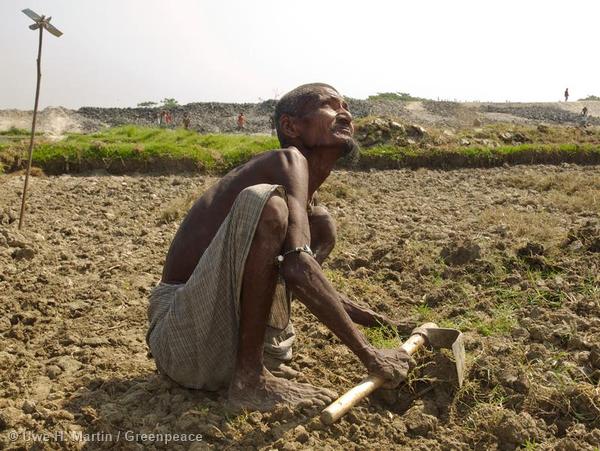This is part of a special series from thethirdpole.net exploring the management of Asia’s transboundary rivers – based on field research by journalists from India, Nepal and Bangladesh, in partnership with the Asia Foundation and Skoll Global Threats Fund.
Also read:
– Engineering disasters: Reporting from along Asia’s shared rivers
– Photo essay: The nowhere people
– Protests scupper India-Nepal dam
– Koshi flood victims struggle on
Large swathes of land slowly turning barren and people being forced into repeated migration with no water to cultivate the Boro paddy crop, the mainstay of their existence… twin disasters are unfolding in northwest Bangladesh, with the Padma and Mahanadi rivers slowly drying up.
A primary reason for this is the Farakka Barrage, built upstream in India 10 km from the border, which has reduced the flow of water to Bangladesh contrary to the bilateral treaty between the two neighbours.
Bangladesh and India have hotly debated how the Farakka Barrage on the Ganga – part of which is known as Padma in Bangladesh – cuts off Bangladesh’s water supply. India used the barrage to divert the river to Calcutta to stop the city’s port drying up during the dry season. This denied Bangladeshi farmers water and silt, and left the Sundarban wetlands and mangrove forests at the river’s delta seriously threatened.
The result – the vast stretch of land in Bangladesh’s Barind Tract region, which produces a major portion of the Boro rice crop, may end up barren unless farmers switch to low-irrigation varieties or the water levels rise in the Padma river and its tributary Mahananda.
For years, farmers in the Barind Tract – covering parts of the Chapainawabganj, Rajshahi and Naogaon districts – have had to rely on underground water for growing irrigation-intensive Boro paddy. This dependency would not have developed had there been enough water in the two rivers, experts say.
Rainfall could have been another natural supply chain for the underground water, but this predominantly dry part of the country has never had much of a rainy season.
“If the current situation prevails, groundwater could be available for another decade or so and then the entire region will turn barren,” warned Mohammed Alam Abdul Mannan, senior sub-assistant engineer of the Barind Multipurpose Development Authority (BMDA) at Nachole in Chapainawabganj.
Official data from BMDA shows that the underground water level dropped from 64 feet in December 2008 to 97 feet in December 2013. However, according to local Boro growers, the level of underground water, which was 40 feet about 15 years ago, has plummeted to 160 feet.
In a double whammy, the usage of groundwater has also gone up sharply. According to a survey of the Bangladesh Agricultural Development Corporation (BADC), groundwater contributed 41% towards irrigation in 1982. Two decades later, in 2002, that climbed to as much as 75%.
The ‘if’ in Farakka
Before the commissioning of the Farakka Barrage in 1972, the Padma was around 100 feet deep during peak periods and 60 feet during lean periods, remember farmers of the Matikata Union in Rajshahi’s Godagari area. In the last few years, this has come down to as little as 15 feet during peak periods and no water at all during the dry season.
“We never had any problem before the Farakka Barrage was installed,” said Hedayet Ali, 60, a fisherman from Godagari.
According to Golam Rabbani, research fellow at the Bangladesh Centre for Advanced Studies (BCAS), a key provision of the 1996 water-sharing treaty says that “if there is water” in the river, India and Bangladesh will alternatively receive 35,000 cubic litres per second (cusec) over 10-day periods from March 11 to May 10 every year.”
However, data from the Joint Rivers Commission (JRC) shows that Bangladesh, the lower riparian country, has often been deprived of the projected volume of water during lean periods.
For example, Bangladesh received the guaranteed volume in 2014, but the flow in 2008, 2009 and 2011 has been less.
Bangladesh has been on the wrong side of the “if”, said a JRC member on condition of anonymity.
Waves of migration
With the Farakka barrage drying up water, families who had migrated in search of a better life find themselves heavily in debt.
Lokman Ali was born in a shoal on the Padma river in Rajshahi district. Nine years ago, when he turned 19, he and his family were forced to leave their home in the Godagiri area and move to the mainland about 50 kilometres away.
For Lokman and others, the Padma river was like a sword that cut on both sides. During monsoon, the river eroded severely and gobbled up vast stretches arable land and hundreds of homesteads. In the dry season, it dried up to such an extent that fertile land in the vicinity turned barren.
But hardships continue to dog their heels in Amnura in neighbouring Chapainawabganj district. Unable to make a profitable living out of cultivation, the only way of life they know, the family is looking at another move.
Lokman and his family are still the Diaras, the “outsiders”, as far as the original inhabitants of Amnura, the Barindas, are concerned. Diaras was traditionally used to describe the moving riverine islands and therefore also the people who kept moving with these islands
“We migrated with hopes for a better life but it has turned out to be a nightmare. Over the last three years, we have not made any profit. And now we are heavily in debt,” said Lokman’s father Anwar Ali.
Initially, Lokman’s family had bought a piece of land in Amnura and cultivated Boro with the irrigation provided by the BMDA. But Boro because of the excessive cost of irrigation, this year they cultivated tomato but failed to make any profit.
In fact, the years of loss has made many of them even poorer than what they used to be while living on the Padma shoals.
Many have already started migrating to urban areas trying to make a living by working as day labourers.
“Last year, one of my brothers moved to Dhaka to work as a construction worker. Now, I am also seriously considering that option. Our family will starve if we keep toiling here,” Lokman said.
Hydrology expert Ainun Nishat said these people would not have needed to migrate had there been enough water in the river.
“If the Padma carried in enough water like it used to do before the commissioning of the Farakka Barrage in India, such a situation would not have arisen,” he said.
Dependency on Boro
Boro plays a key role in the country’s food security by accounting for nearly 60% of the total rice production. But the crop, which ensures food for people with low income, is a difficult variety of paddy because it has to be grown in the dry season and requires a lot of water.
Boro is a traditional rice variety which became hugely popular because of its high yield and fast growth and its tolerance to floods. But it is also extremely water intensive. According to the Bangladesh Rice Research Institute (BRRI), every kilogramme of Boro paddy requires around 4,000 litres of water.
With groundwater levels plummeting, growing the crop has become increasingly difficult and expensive. “A few years ago, I would spend 100 takas (a little over a dollar) for an hour of irrigation. The water I got was enough for my one-bigha of land [a traditional measure of land]. But now, even three hours of irrigation cannot fetch the water that I need,” said Asharfaul Islam, a farmer from Chuniapara village in Tanore area of Rajshahi district.
The government has also tried to introduce a new water-saving technology called the alternative wet and dry method, developed by BRRI. Under this, every kilogramme of rice only requires 700 litres of water. It has also been trying to popularise less irrigation-intensive crops such as wheat and maize, but farmers are reluctant to switch.
Rajendro Sarker, a farmer from the Mundulmala village in Rajshahi, said: “We cannot stop growing Boro because we know everything about this. Even if it requires huge volume of groundwater for irrigation, we cannot think about any alternative.”

